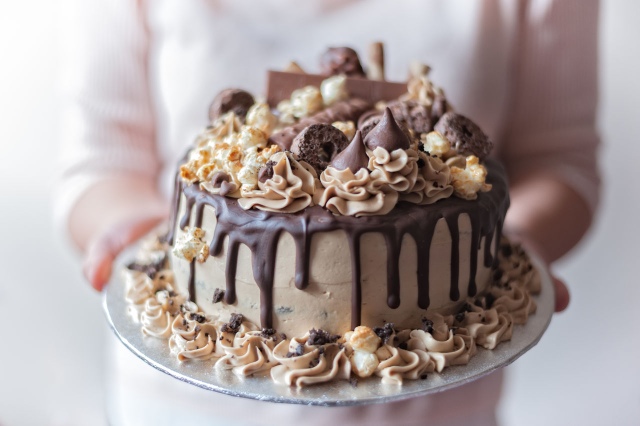The Buttercream Effect
Also this has been in my drafts folder for so long but I got caught up again and so this marks as my first post of the year 2017 - halfway through the year though but at least I was able to catch up.
I have been experimenting these past few months and have decided to level up my simple cream frosting into buttercream. I had a love and hate relationship with buttercream in the past. For some reason, there are instances where it was so good but since I was not doing it regularly, I think I might have missed something and when I do it again, it would turn out to be "not so good." It was either too runny or wet or it would start out okay, but then before I could finish frosting the cake, it would start to melt or worst, it just liquifies and I'm screwed. The only saving grace for me, is when I make chocolate buttercream because when I add the melted chocolate, it makes it more firm.
After some trial and error, I have learned some "secrets" to make good buttercream (at least enough to make the good swirl). I have also tried both spreadable and block butters just to see if there is any difference. There is also the difference between using icing sugar versus sugar & egg white mixture. And of course, along the way, I have finally discovered the buttercream that definitely tastes like Goldilocks. Yes, how I missed it and it has reminded me of the good old days when my dad would bring these log cakes for pasalubong. A bit tedious to do but I have been used to it. After I have "discovered" this, I have never looked back since and have been using it on my cakes and cupcakes. It has this different feel whenever I would frost my cakes and when I would squeeze the icing bag, it just has this smoothness once it comes out. I feel like I can control it more and it is consistent from the start to the end of my frosting/decorating as compared to cream frosting when it starts to melt or soften when I've been frosting way too long.
BASIC BUTTERCREAM FROSTING
2 blocks of butter*
2 1/2 to 3 cups of icing sugar
1 to 1 1/2 tsp flavouring
2 tbsp cold milk
(if chocolate) 1 bar baking chocolate and 1 tsp coffee dissolved in 1 tbsp hot water
Cream the butter using a handheld or stand-in mixer. Gradually add the icing sugar and milk, alternately (start a lower speed then gradually increase) until they are incorporated and buttercream is light and fluffy. Add the flavouring and chocolate, if applicable.
*Blocks in the UK is equivalent to two small but long blocks in the US. By block, I mean 250 grams of butter.
At the moment, I have tried experimenting a mix of 1 block of butter, cut into cubes and 250g equivalent of spreadable butter. So far, so good. I think it is the cold milk the makes the difference. Before, my butter was runny but I was not adding milk to it, simply because I thought it would worsen it and also the earlier recipe I followed, did not use milk. I also noticed that it was easier before when I was using a hand-held mixer and when I tried with a stand-in mixer, these were the instances where I frequently had the runny buttercream. But now, it seems to be okay. In terms of the difference with Swiss Meringue Buttercream, there are grainy bits in the basic buttercream although I have noticed that using a mix of spreadable and block butter, makes it a bit smoother and brings it closer to the Swiss Meringue Buttercream consistency. Also using vegan versions - i.e. avocado or coconut butter, olive oil and other forms also makes it more into a smooth consistency although there is a risk that it is soft and does not harden even when chilled. There is also a bit difference in taste.
I have been experimenting these past few months and have decided to level up my simple cream frosting into buttercream. I had a love and hate relationship with buttercream in the past. For some reason, there are instances where it was so good but since I was not doing it regularly, I think I might have missed something and when I do it again, it would turn out to be "not so good." It was either too runny or wet or it would start out okay, but then before I could finish frosting the cake, it would start to melt or worst, it just liquifies and I'm screwed. The only saving grace for me, is when I make chocolate buttercream because when I add the melted chocolate, it makes it more firm.
After some trial and error, I have learned some "secrets" to make good buttercream (at least enough to make the good swirl). I have also tried both spreadable and block butters just to see if there is any difference. There is also the difference between using icing sugar versus sugar & egg white mixture. And of course, along the way, I have finally discovered the buttercream that definitely tastes like Goldilocks. Yes, how I missed it and it has reminded me of the good old days when my dad would bring these log cakes for pasalubong. A bit tedious to do but I have been used to it. After I have "discovered" this, I have never looked back since and have been using it on my cakes and cupcakes. It has this different feel whenever I would frost my cakes and when I would squeeze the icing bag, it just has this smoothness once it comes out. I feel like I can control it more and it is consistent from the start to the end of my frosting/decorating as compared to cream frosting when it starts to melt or soften when I've been frosting way too long.
BASIC BUTTERCREAM FROSTING
2 blocks of butter*
2 1/2 to 3 cups of icing sugar
1 to 1 1/2 tsp flavouring
2 tbsp cold milk
(if chocolate) 1 bar baking chocolate and 1 tsp coffee dissolved in 1 tbsp hot water
Cream the butter using a handheld or stand-in mixer. Gradually add the icing sugar and milk, alternately (start a lower speed then gradually increase) until they are incorporated and buttercream is light and fluffy. Add the flavouring and chocolate, if applicable.
*Blocks in the UK is equivalent to two small but long blocks in the US. By block, I mean 250 grams of butter.
At the moment, I have tried experimenting a mix of 1 block of butter, cut into cubes and 250g equivalent of spreadable butter. So far, so good. I think it is the cold milk the makes the difference. Before, my butter was runny but I was not adding milk to it, simply because I thought it would worsen it and also the earlier recipe I followed, did not use milk. I also noticed that it was easier before when I was using a hand-held mixer and when I tried with a stand-in mixer, these were the instances where I frequently had the runny buttercream. But now, it seems to be okay. In terms of the difference with Swiss Meringue Buttercream, there are grainy bits in the basic buttercream although I have noticed that using a mix of spreadable and block butter, makes it a bit smoother and brings it closer to the Swiss Meringue Buttercream consistency. Also using vegan versions - i.e. avocado or coconut butter, olive oil and other forms also makes it more into a smooth consistency although there is a risk that it is soft and does not harden even when chilled. There is also a bit difference in taste.
photo courtesy of my hubby's EP Creative Photography
SWISS MERINGUE BUTTERCREAM FROSTING
2 egg whites
1 cup sugar
2 sticks butter/1 block butter
Mix the egg whites and sugar then place the container over a pan of simmering water. Mix until sugar is dissolved. It should be smooth when rubbed between fingertips. Whisk using a handheld or stand-in mixer until stiff. Wait to cool before adding the butter gradually. Add any flavouring. Continue to whisk until fluffy.
This is just a small cake buttercream recipe so you may double it if required. I have also tried using liquid egg whites as I do not want to waste the egg yolks - unless you plan on making custard which is also a good idea for a cake filling (just mix with condensed milk and cook until thickened; if it becomes too thick, just add a bit of milk). Please also make sure that the sugar has completely dissolved as it happened in one of my earlier tries (or rather fails lol) that I got impatient and went ahead without the sugar dissolving completely. The end product of the buttercream, whilst really good, was a big grainy. I also had some "incidents" with the egg white and sugar mixture, I must have beaten it too much in the mixer that it never turned fluffy. I ended up making sugar icing toppers as I don't want to throw it away. I guess the secret to these fails or near fails is just to keep beating it in the mixer until soft peaks form again. The turning point is usually when you add the butter and the fluffiness/air may seem to disappear BUT patience is key - just bloody wait.
It is also a challenge doing this in the summer months as the buttercream seems to be a bit delicate when the weather is hot. But this is still my favourite frosting because it is just so silky and easier to manipulate when you are decorating. I guess the difference with just plain buttercream is it does not melt too much, in the sense that it does not become too liquidy and separates when only a small amount is left. And if there are some left overs which you store in the fridge, when you bring it out to be used again, it does not change it's consistency as compared to buttercream that becomes a bit softer and "melted." It's only as good as fresh - maybe it's the milk, I don't know. I have noticed with buttercream that I usually start really good but then when I'm trying to use up the remaining frosting - it starts to soften and the pattern I decorated from the start has deformed a bit. Of course, you can still pop it in the fridge to harden but still, it does not have that consistency from start to finish.
I know the process for Swiss Meringue is a bit more tedious but I don't mind and I'm now used to it - as long as the end product meets my expectations, it definitely outweighs everything.
Watch this space for the Italian Meringue Buttercream. It is just hectic ATM so I will try this when I get the chance to do some experiments. For the meantime, my next post may be about my latest obsession with choco side drips on my cakes and/or the making of those buttercream flowers. Still learning on these two tricks but I think I'm getting there.









Comments
Post a Comment